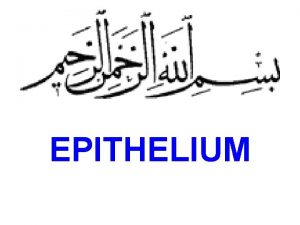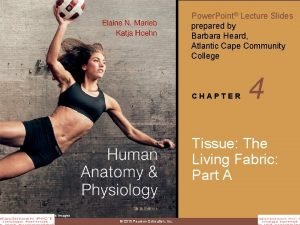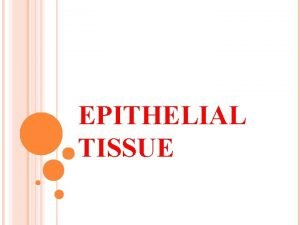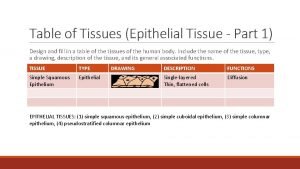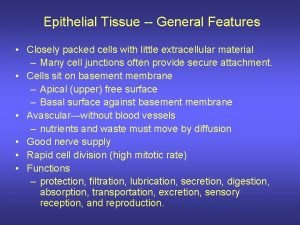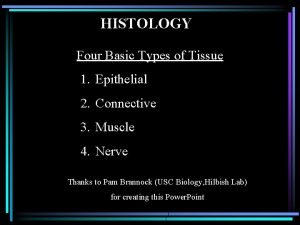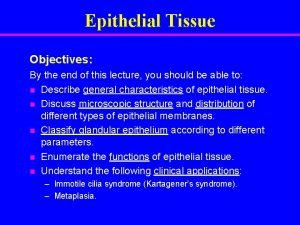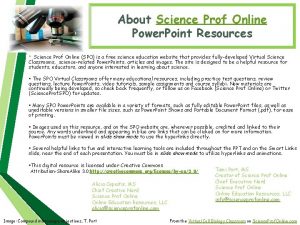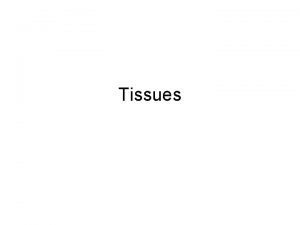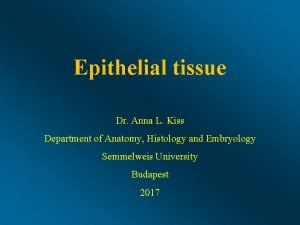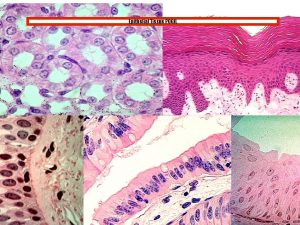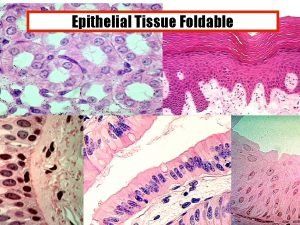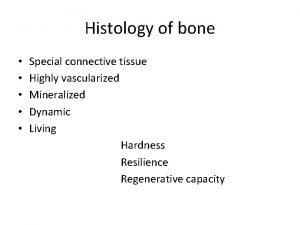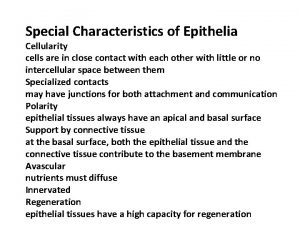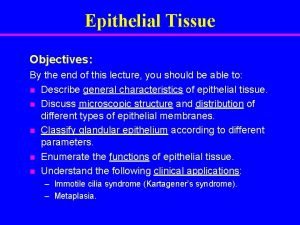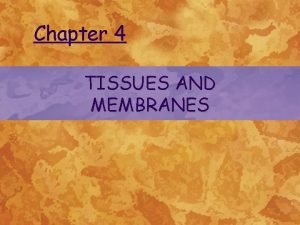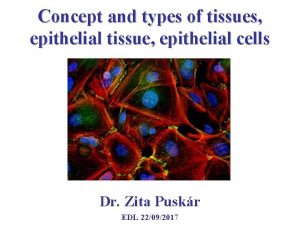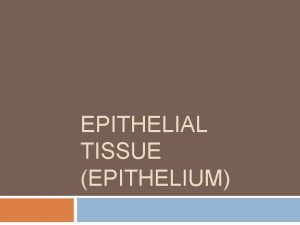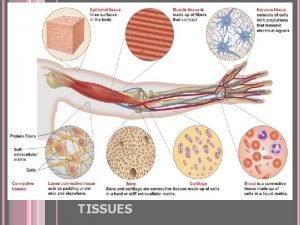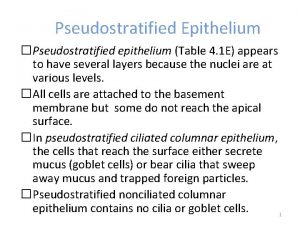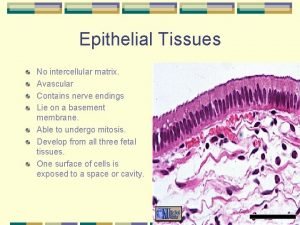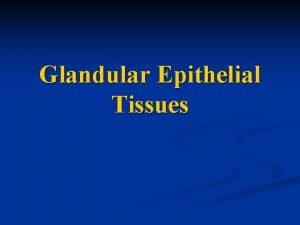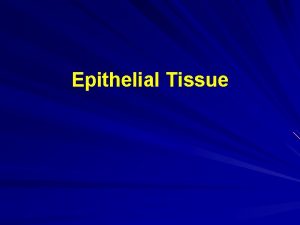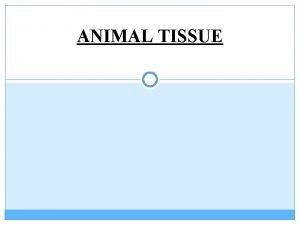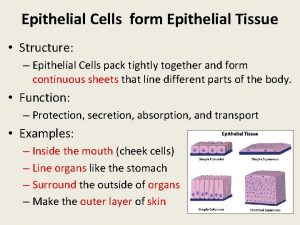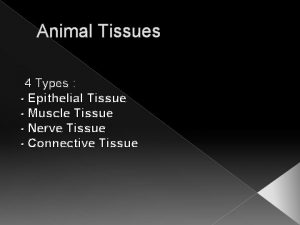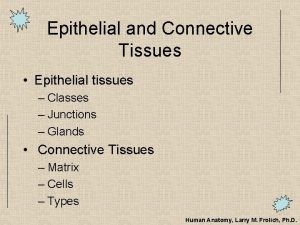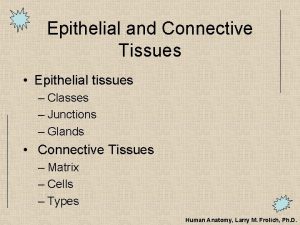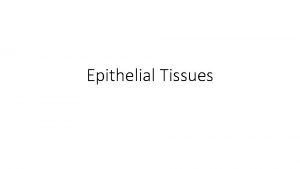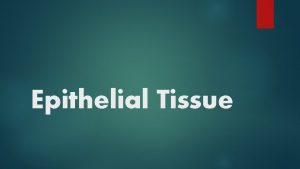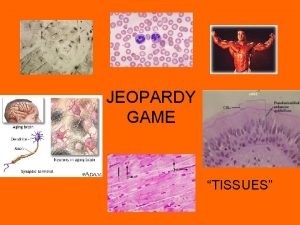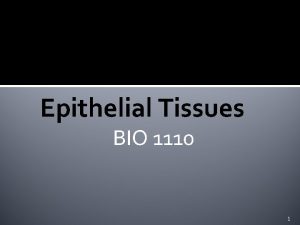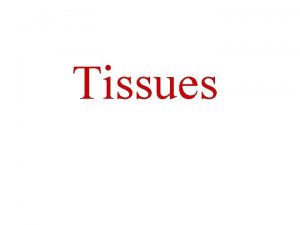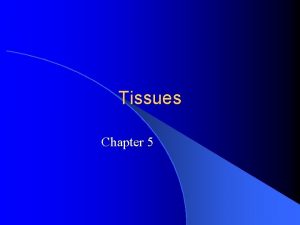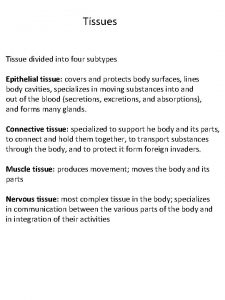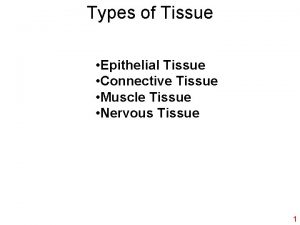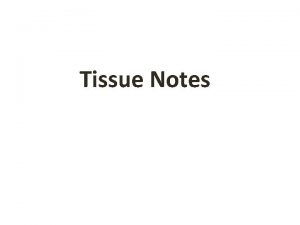ANIMAL TISSUES 1 Epithelial tissue n Animal tissues






























- Slides: 30

ANIMAL TISSUES

1. Epithelial tissue n Animal tissues n Epithelial tissue n Connective tissue n Muscular tissue n Nervous tissue Epithelial tissues are sheets of densely packed, tightly connected cells that cover in ner and outer body surfaces n n They form the skin and line hollow organs of the body, such as the gut Some epithelial cells have secretory functions Cells are aligned over a connective tissue. They don’t have blood vessels and nerves they frequently have protective as well as absorptive, transport and receptor functions. http: //bioweb. uwlax. edu/zoolab/Table_of_Contents/Lab 1 b/lab 1 b. htm

Table 4. 1 Epithelial Tissue Type Description Simple squamous One layer of flattened cells Stratified squamous Many layers; cell flattened at surface Simple cuboidal One layer of cube shaped cells Simple columnar One layer of elongated cells Pseudostratified columnar Appears to be layered but is notn layered Transitional When tissue stretches, layers become fewer

SIMPLE EPITHELIAL

STRATIFIED EPITHELIAL Keratinsiz çok katlı yassı epitel AĞIZ İÇİ Çok katlı değişken epitel İDRAR KESESİ Keratinli çok katlı yassı epitel DERİ

SECRETORY EPITHELIAL Exocrine glands - Endocrine glands Salivary gland, digestive glands– hormonal glands(hypophysis, thyroid), pancreas,

n n n A gland consists of one or more cells that produce and secrete a product. Most glands are composed primarily of epithelium in which the cells secrete their product by exocytosis. The mucus secreting goblet cells within the columnar ep ithelium lining the digestive tract are single cells. Glands with ducts that secrete their product onto the outer surface (e. g. , sweat glands and mammary glands) or into a cavity (e. g. , pancreas) are called exocrine glands. Glands that no longer have a duct are appropriately known as the ductless glands, or endocrine glands. Endocrine glands (e. g. , pituitary gland thyroid) secrete their products internally so they are transported by the bloodstream. Endocrine glands produce

TEK HÜCRELİ ÇOK HÜCRELİ MUKUS GOBLET HÜCRELERİ Kanallı salgı bezleri tükrük Kanalsız salgı bezleri hipofiz Karma salgı bezi pankreas Yağ bezi

Receptor(sensory) epithelial cells Dilde tat alma epiteli Deride dokunma duyu epiteli

2. Connective Tissue n n Connective tissue binds structures together, provides support and protection, fills spaces, produces blood cells, and stores fat Connective tissue cells are widely separated by an extracellular matrix. Matrix includes fibers( collagen, fibrous and reticular) Ex. Bone, cratilage, adipose, blood

Classification of Connective Tussue Type Structure Location (Good Example) Collagenous and elastic fibers Between tissues and organs Beneath skin Fibrous Connective Loose connective Adipose Dense connective Regular Irregular Reticular connective Cartilage Hyaline cartilage Elastic cartilage Fibrocartilage Bone Compact Spongy Blood Fibroblasts enlarge and store fat Bundles of parallel collagenous fibers Bundles of nonparallel collagenous fibers Reticular fibers Tendons and ligaments Dermis of skin Fine collagenous fibers Many elastic fibers Strong collagenous fibers Ends of long bones External ear Between vertebrae Osteons Trabeculae, red bone marrow Plasma plus cells Skeleton Ends of long bones Blood vessels Lymphatic organs and liver

n n n Binds organs together The major cells are fibroblasts, as they get older they are called fibrocytes Contain collagen and elastic fibers Mast cells secrete heparin(unclotting agent) histamin Macrophages and white blood cells helps immunity

n n In cartilage, the cells (chondrocytes), which lie in small chambers called lacunae, are separated by a matrix that is solid yet flexible. Unfortunately, because this tissue lacks a direct blood supply, and nerve endings it heals very slowly. The three types of cartilage are classified according to the type of fiber in the matrix. Hyaline cartilage is the most common type of cartilage. The matrix, which contains only very fine collagenous fibers, This type of cartilage is found in the nose, at the ends of the long bones and ribs, and in the supporting rings of the trachea. The fetal skeleton is also made of this type of cartilage, although the cartilage is later replaced by bone. Elastic cartilage has a matrix containing many elastic fibers, in addition to collagenous fibers. For this reason, elas tic cartilage is more flexible than hyaline cartilage. Elastic car tilage is found, for example, in the framework of the outer ear. Fibrocartilage has a matrix containing strong collagenous fibers. This type of cartilage absorbs shock and reduces friction between joints. Fibrocartilage is found in structures that withstand tension and pressure, such as the pads between the

Bone n n n Extracellular matrix is solid Cells are called as Osteocytes are connected with each other by canaliculi Spongy bone Compact bone contains haversian system Periosteum regenerates the bone tissue

Bone is the most rigid of the connective tissues. It has an extremely hard matrix of mineral salts, notably calcium salts, deposited around protein fibers. The outer portion of a long bone contains compact bone. Compact bone consists of many cylindrical shaped units called an osteon, or Haversian system. In an osteon, matrix is deposited in thin layers called lamellae that form a concentric pattern around tiny tubes called central canals. The canals contain nerve fibers and blood vessels. The blood vessels bring nutrients to bone cells (called osteocytes) that are lo cated in lacunae between the lamellae. The nutrients can reach all of the cells because minute canals (canaliculi) containing thin extensions of the osteocytes connect the osteocytes with one another and with the central canals. The ends of a long bone contain spongy bone, which has an entirely different structure. Spongy bone contains numerous bony bars and plates called trabeculae separated by irregular spaces. Although lighter than compact bone, spongy bone is still designed for strength. Like braces used for support in buildings, the solid portions of spongy bone follow lines of stress. Blood cells are formed within red marrow found in spongy bone at the ends of certain long bones.

Adipose • Cells are lipoblasts • Stores fat(triglycerides) • Have well developed blood capillaries


Blood • Blood is composed of cells and plasma • Plasma contains water, protein, inorganic mol, hormones, excretory products, glucose, gases • Plasma proteins- albumin, globulin, fibrinogen is important for ozmotic equalibrium and clotting • Serum doesn’t have clotting proteins • Cells white blood cells(leucocytes), Red blood cells(erythrocytes) , blood platelets thrombocytes(part of the megakaryocyte)

Red blood cells dont have nucleus and mitochondria. They can not divide. They can not do oxidative phosphorylation. Carry hemoglobin to carry oxygen. n Antigen is a protein in the cell membrane of the red blood cells. They function in the recognition of the foreign molecules like antibodies. n Antibodies are proteins that are formed by the immune system as a response to foreign molecules. n

Blood groups http: //nobelprize. org/medicine/educational/landsteiner/readmore. html

Rh system ( is shown by D )

Erythroblastosis fetalis n n n A severe hemolytic disease of a fetus or newborn infant caused by the production of maternal antibodies against the fetal red blood cells, usually involving Rh incompatibility between the mother and fetus. If the mother is rh – , and baby is Rh , mother can produce antibodies against the blood of baby and can kill her. If the mother is rh – and father is Rh + , the care should be taken.

1. Kanında sadece B antijeni bulunan bir kişinin kan grubu nedir? n B 2. Kanında sadece B antikoru bulunan bir kişinin kan grubu nedir? A 3. AB rh – kan grubuna sahip olan kişinin antijen ve antikorlarını belirtiniz. n



Muscular tissue n Muscles have cantractile fibers that are formed by proteins. These proteins are actin and myosin.

Skeletal muscle n n n Voluntary Striated because Actin ve myosin molecules are arranged regularly. Long fibers Multinucleated Nuclei are at the periphery Cardiac muscle Smooth muscle n n n n Involuntary Actin and myosin molecules are not arranged regularly Spindle shaped Only 1 nucleus At the center n n n Involuntary Striated because Actin ve myosin molecules are arranged regularly. Long but branched fibers Cells have intercalated discs Nucleus can be 1 or two at the center

Nervous tissue n n n Nervous tissue, found in the brain and spinal cord, contains specialized cells called neurons that conduct nerve impulses. A neuron has three parts: (1) A dendrite collects signals that may result in a nerve impulse; (2) the cell body contains the nucleus and most of the cytoplasm of the neuron; and (3) the axon conducts nerve impulses. Neurons can not divide rich in mitochondria. nervous tissue also contains neurogliasupporting cells


 Body tissues chapter 3 cells and tissues
Body tissues chapter 3 cells and tissues Chapter 3 cells and tissues answer key
Chapter 3 cells and tissues answer key Body tissues chapter 3 cells and tissues
Body tissues chapter 3 cells and tissues Cells form tissues. tissues form __________.
Cells form tissues. tissues form __________. Body tissue
Body tissue Stratified squamous keratinized epithelium
Stratified squamous keratinized epithelium Exocrine glands
Exocrine glands Stratified squamous non-keratinized epithelium
Stratified squamous non-keratinized epithelium Table of tissues
Table of tissues Filtration epithelial tissue
Filtration epithelial tissue Epithelial tissue
Epithelial tissue Epithelial tissue
Epithelial tissue Renderforest
Renderforest Layers of epithelial tissue
Layers of epithelial tissue Gianuzzi demilune
Gianuzzi demilune Epithelial tissue pogil
Epithelial tissue pogil Basic histology pogil
Basic histology pogil Is epithelial tissue highly vascularized
Is epithelial tissue highly vascularized Epithelial tissue
Epithelial tissue Histology smooth muscle
Histology smooth muscle Cellularity of epithelial tissue
Cellularity of epithelial tissue Cuboidal epithelial tissue function
Cuboidal epithelial tissue function Epithelial tissue
Epithelial tissue Secretory tissue
Secretory tissue Epithelial tissue
Epithelial tissue Kidney epithelial tissue
Kidney epithelial tissue Epithelial tissue
Epithelial tissue Stratified columnar epithelium
Stratified columnar epithelium Epithelial tissue
Epithelial tissue Epitelio glandular holocrino
Epitelio glandular holocrino Epithelial tissue
Epithelial tissue





